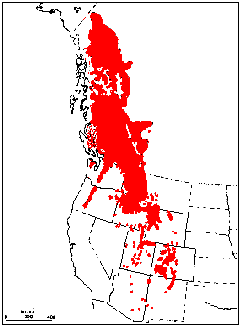
The range of A. lasiocarpa combined with that of A. bifolia (5).
Common Names
Rocky Mountain alpine fir, Rocky Mountain subalpine fir, corkbark fir (1).Taxonomic notes
Syn: Abies subalpina Engelmann. "Abies bifolia has been - and by many workers still is - included in synonymy under A. lasiocarpa or A. subalpina since about 1890, and A. subalpina under A. lasiocarpa since about the 1920s. Abies bifolia is distinct from A. lasiocarpa, however, in chemical tests on wood (Fraser and Swan 1972), lack of crystals in the ray parenchyma (Kennedy et al. 1968), lack of lasiocarpenonol (Manville and Tracey 1989), and distinct terpene patterns (Hunt and von Rudloff 1979). Abies bifolia also tends to have slightly shorter and fewer prominently notched leaves than A. lasiocarpa. The two are clearly separated by the color of their periderm and by the shape of their basal bud scales. These firs may be more distinct than the pairs A. balsamea-A. fraseri and A. procera-A. magnifica. A north-south transect, however, from south central Yukon to northern Washington yielded introgressed trees possessing characteristics of both A. lasiocarpa and A. bifolia, recalling the interior spruce (Canadian Forestry Service 1983), which has characteristics of both Picea glauca and P. engelmannii. These trees can similarly be called interior subalpine fir, i.e., A. bifolia × lasiocarpa. Both A. lasiocarpa and A. bifolia need comparative morphologic studies" (1)."Isolated southern populations of Abies bifolia may also have unique characteristics. The taxonomy of corkbark fir, treated by some as A. lasiocarpa var. arizonica (Merriam) Lemmon, is uncertain. This taxon should probably be a segregate of A. bifolia, not A. lasiocarpa, a disposition that requires a thorough morphologic and chemical reappraisal, especially since the work of E.Zavarin et al. (1970) suggested that populations south of Wyoming may have unique terpene patterns. In north central Alberta, A. bifolia introgresses with A. balsamea (Hunt and von Rudloff 1974; Moss 1953)" (1).
Description
Tree: Up to 30 m tall and 45 cm dbh with a spire-like crown (1).Bark: Gray, thin, smooth, becoming furrowed and scaly with age. Towards the southern end of the range, the 'corkbark fir' has thickened, 'corky' bark that may be dark grey, deeply furrowed (1).
Branches: Diverge from the trunk at right angles (1).
Shoots: Twigs stout, stiff, opposite to whorled, grayish with sparse light brown pubescence; fresh leaf scars expose a light brown periderm (1).
Leaves: Spiraled and turned upward, flexible, apex slightly notched to rounded, 11-25 × 1.25-1.5 mm; cross section flat with an adaxial groove; odor similar to camphor; lower surface with 3-5 lines of stomata on each side of midrib; upper surface light green to bluish green, usually glaucous, with 3-6 rows of stomata at midleaf; stomatal rows are usually continuous to leaf base and are more numerous toward leaf apex; resin canals are large, ± medial. Buds are exposed, brown, globose, small, resinous, with a rounded apex; basal scales are long, narrow, triangular to spathulate, and glabrous, margins are entire to rarely crenate with a sharp-pointed or rounded apex. Cotyledons 3-6 (1).
Cones: Cylindric with a rounded apex, sessile, 5-10 × 3-3.5 cm, dark purple-blue to grayish purple (1).
Cone scales: Densely pubescent; ca. 1.5 × 2.5 cm, with included bracts (1).
Pollen cones: Purplish at time of pollination (1).
Seeds: Brown, 5-7 × 2-3 mm, with a grayish brown wing about 1.5 times as long as the nut (1).
Range
Canada: in southern Yukon Territory, the Northwest Territories, the Rocky Mountains of Alberta, and the interior plateaus and Rockies of British Columbia. USA: Washington, Oregon, Idaho, Montana, Wyoming, Colorado, New Mexico, Arizona, Utah and Nevada at 600-3700 m in continental subalpine conifer forests of the Rocky Mountain area, the Intermountain Ranges, and the Wallowas of eastern OR (1, 2). It is found growing to the alpine treeline in most of its range. In most of the Rocky Mountains, it forms a major forest type with Picea engelmannii (3).Big Tree
Oldest
Sampled one tree in the Medicine Bow Mountains, WY, aged 494 years with over 90% of the age verified by cross-dating (4).Dendrochronology
Numerous studies of forest age structure have been conducted, some of which (e.g., (4)) have used dendrochronological methods.Ethnobotany
Observations
Remarks
Citations
(1) Richard S. Hunt at the Flora of North America web site.(2) Peattie 1950 (as A. lasiocarpa).
(3) Little 1980 (as A. lasiocarpa).
(4) Earle 1993.
(5) Fowells 1965.
[Abies] [Pinaceae] [home]
This page is from the Gymnosperm Database
URL: http://www.geocities.com/RainForest/Canopy/2285/pi/ab/bifolia.htm
Edited by Christopher J. Earle
E-mail:earlecj@earthlink.com
Last modified on 28-Jan-1999